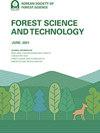Seasonal variations in accumulated particulate matter on leaves of four major tree species in Korea
IF 2.2
Q2 FORESTRY
引用次数: 2
Abstract
Abstract Tree planting is a countermeasure used to mitigate the effects of the high concentrations of atmospheric particulate matter (PM), because trees have a strong ability to adsorb PM. However, owing to the limited information on PM accumulation on leaves throughout the year, guidelines for the implementation of urban forests cannot be provided. Therefore, in this study, we measured PM accumulation in leaves to compare the PM-reducing ability of four common species (Metasequoia glyptostroboides, Prunus yedoensis, Spirea prunifolia f. simpliciflora, and Zelkova serrata) during one growing season. We collected leaves almost every two weeks from 7 May to 23 October 2019, in Seoul Forest Park. We then measured the PM quantities on the leaves before and after rainfall (28 mm/h) to determine the amount of PM that washed off. We found that the average PM10 (PM <10 µm in diameter) accumulation on the leaves of S. prunifolia f. simpliciflora, Z. serrata, M. glyptostroboides, and P. yedoensis during one growing season was 68.1, 58.3, 43.5, and 28.2 mg/m2, respectively. The average PM2.5 (PM <3 µm) accumulation on the leaves of S. prunifolia f. simpliciflora, Z. serrata, M. glyptostroboides, and P. yedoensis was 18.2, 11.6, 7.8, and 6.5 mg/m2, respectively. However, the accumulation of both PM10 and PM2.5 on the leaves of the four species fluctuated during the sampling period. The average ratio of PM2.5 to PM10 accumulation in the leaves of S. prunifolia f. simpliciflora and P. yedoensis was significantl higher than that of Z. serrata and M. glyptostroboides; however, this ratio fluctuated throughout the sampling period. Rainfall considerably reduced the levels of PM10 on the leaves of P. yedoensis and PM2.5 on the leaves of M. glyptostroboides. We found no significant removal of PM from the leaves of other species. These results indicated that the PM-reducing ability of trees varies between species and over time. Therefore, urban forests should be managed with a high diversity of tree species.韩国四种主要树种叶片上累积颗粒物的季节变化
植树造林是缓解高浓度大气颗粒物(PM)影响的一种对策,因为树木具有很强的吸附PM的能力。但是,由于关于全年叶片上颗粒物积累的资料有限,因此无法提供实施城市森林的准则。因此,在本研究中,我们测量了四种常见树种(水杉、叶李、单叶Spirea prunifolia f. yedoensis、泽尔科瓦(Zelkova serrata))在一个生长季节内叶片中的PM积累量,以比较它们的PM还原能力。从2019年5月7日至10月23日,我们几乎每两周在首尔森林公园收集一次树叶。然后,我们测量了降雨(28毫米/小时)前后叶片上的PM量,以确定被洗掉的PM量。结果表明,单叶扁柏、剑齿苋、草叶扁柏和叶红叶扁柏的PM10(直径<10µm)在生长季的平均累积量分别为68.1、58.3、43.5和28.2 mg/m2。PM2.5 (PM <3µm)在单叶李、锯齿木、草木和紫杉叶片上的平均累积量分别为18.2、11.6、7.8和6.5 mg/m2。然而,在采样期间,4种植物叶片上PM10和PM2.5的积累都存在波动。单叶扁柏和红叶扁柏叶片中PM2.5与PM10的平均积累比显著高于锯齿扁柏和草叶扁柏;然而,这一比例在整个抽样期间有所波动。降雨显著降低了叶青树叶片上的PM10和草叶上的PM2.5水平。我们发现其他物种的叶片中没有明显的PM去除。这些结果表明,树木减少pm的能力因物种和时间而异。因此,城市森林应以高度多样化的树种进行管理。
本文章由计算机程序翻译,如有差异,请以英文原文为准。
求助全文
约1分钟内获得全文
求助全文

 求助内容:
求助内容: 应助结果提醒方式:
应助结果提醒方式:


